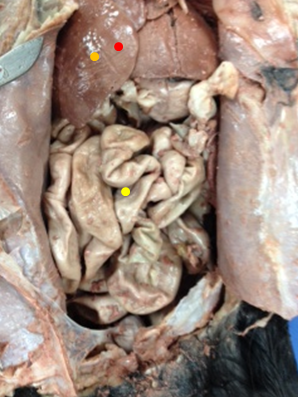- Mouth
-mastication
-deglutition
-start of digestion (starch)
-self-cleaning
-holding food
Secretions:
-Saliva from salivary glands (parotid, sublingual,
submandibular)- prepare food for swallowing, prevent mouth
from drying, and start the breakdown of starch
-Amylase- digests starch
-Saliva from salivary glands (parotid, sublingual,
submandibular)- prepare food for swallowing, prevent mouth
from drying, and start the breakdown of starch
-Amylase- digests starch
Histology: stratified squamous epithelium
- Stomach
-temporary food storage
-mechanical breakdown of food
-breakdown of chemical bonds by acids and enzymes
-production of intrinsic factor needed for vitamin B12
absorption
absorption
-begins the breakdown of proteins
Secretions:
-mucous- protects the stomach lining
-gastric juices- softens meat and bones, kills bacteria in food,
activates protein-digesting pepsinogen
activates protein-digesting pepsinogen
-Hydrochloric acid
Histology: simple columnar epithelium with mucous cells
- Small Intestine
-completes the digestion of food
-absorbs end products into blood and lymph
-secretes hormones that help control production of pancreatic
juice, intestinal juice, and bile
juice, intestinal juice, and bile
-controls the amount of fluid and electrolytes lost from the
body
body
Secretions:
-paptidase- digest proteins
-maltase, sucrase, lactase- digest disaccharides
-lipase- digest lipids
-bicarbonate ions- act as emulsifying agents
-secretin- stimulates the pancreas to secret a fluid high in
bicarbonate ions that help neutralize chyme
bicarbonate ions that help neutralize chyme
-CCK- stimulates the release of bile from the gallbladder and
the secretion of digestion enzymes from the pancreas
the secretion of digestion enzymes from the pancreas
Histology: simple columnar epithelium
- Liver
-produces bile and plasma proteins
-detoxifies blood
Secretions:
-bile- lowers the surface tension of fats, forming small droplets
Histology: dense connective tissue
presence of fatty acids
- Gallbladder
presence of fatty acids
Secretions: bile
Histology: simple columnar epithelium
- Pancreas
-secretes enzymes into the cavities and blood
-neutralizes chyme
Secretions:
-amylase- digest starch into maltose
-trypsin- digest proteins
-lipase- digest lipids
-nucleases- digest nucleic acids
-sodium bicarbonate ions- neutralize chyme
Histology: simple cuboidal epithelium
- Large Intestine
-reabsorb water
-store wastes
Secretions: none
Histology: simple columnar epithelium
- Rectum
Secretions: none
Histology: smooth muscle
- Anus
Secretions: none
Histology: simple columnar epithelium











